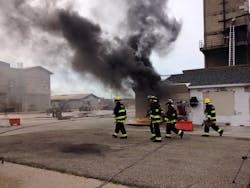Study Looks at Health Threats to Firefighters
CHAMPAIGN, ILL. – Firefighters often assume when they’re encapsulated in turnout gear, they’re protected from toxins and carcinogens.
But, that may not be the case.
During a collaborative research project underway now at the Illinois Fire Service Institute (IFSI), researchers are not only testing contaminates on the gear, but on skin as well. They’re also monitoring gases created as furniture and carpeting burn.
But, that’s just part of the multi-faceted study involving researchers from IFSI, UL, NIOSH, University of Illinois, Chicago, and Skidmore College.
On Monday morning before 12 Illinois firefighters and researchers got underway for the first day, they paused as the National Anthem was played. After that, it was time to get to work.
Each firefighter had blood drawn, vitals and temperatures checked. Urine samples were tested for certain markers as well as hydration. They were equipped with a device that will monitor the heart for the next 12 hours.
Dr. Denise Smith explained that part of the research is determining the impact of firefighting on the cardio-vascular system. “We talk about putting the rig back in service. How long does it take to get a firefighter back in service? We’re looking to see if there are changes hours after the firefighter does their work.”
Each year, dozens of firefighters die not on the fireground, but hours after the incident.
Firefighters participating in the study donned new gear to make sure samples were not skewed. They carried three chemical collection units, smaller than portable radios, in their coat pockets. When they completed their tasks, it was removed and tested.
UL and NIOSH engineers set up sensitive equipment to monitor gases and heat inside the rooms that would burn or exposed to smoke and heat.
UL Research Engineer Robin Zevotek set up thermal sensors from the floor to ceiling two feet apart in rooms that would burn. In other areas, they were placed a foot apart. During the scenario, he would be able to watch the temperatures on a nearby monitor.
In a hallway, devices would capture the data at one, three and five foot levels. The lowest would be where a victim would likely be, while others would be firefighters either crawling or walking.
Sean DeCrane, a battalion chief from Cleveland, who watched the effort said it’s important for personnel to know what they’re exposed to.
“Some think if they’re not burned, they’re OK. But, that’s not true." DeCrane said. "They don’t know what they’ve been exposed to. That’s why this research is important.”
Smith praised the firefighters for their participation. “We consider you our research partners…”
